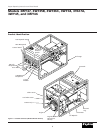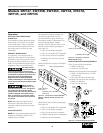
Dayton Operating Instructions and Parts Manual
11
Version B - For Reduction G016.J
®
Models 3WY47, 3W735B, 3W736C, 3WY44, 3TE27A,
3WY45, and 3WY46
STANDBY INSTALLATION TO HOME
OR BUILDING
Have standby
installation
performed by a skilled, licensed
electrician. Do not let anyone else wire
into a utility circuit. Personal injury,
equipment damage, or damage to
home could occur.
IMPORTANT: This generator will not
power your entire home. Most home
utility electric service is more than 60
amps. This will exceed generator output.
Only power needed items during a power
outage. Make sure total wattage of
electrical load does not exceed rated
wattage of generator.
You can use this generator as a standby
power source. During a power outage, the
generator will power selected items in a
building. Have generator and additional
wiring installed by a skilled, licensed
electrician. This is not a do-it-yourself job.
Follow all local codes.
The electrician must
install a double-
throw transfer switch. This isolates
existing electrical circuits from the
utility power line. If not isolated,
generator output will back-feed into
utility power line. This may electrocute
a power company line repair person.
construction sites, you must use a GFCI.
United States OSHA and the National
Electric Code requires this.
You may need to provide the GFCI device.
Purchase GFCI at any electrical supply
house. Check the Yellow Pages for the
nearest supply house.
DUST, DIRT, RAIN, AND SNOW
Do not use
generator out-
doors in rain or snow. Do not use
generator near standing water or
snow. Do not use if generator is wet or
damp. Operating generator in these
conditions increases the risk of electro-
cution. Severe injury or death can
occur.
Do not use generator in extremely dusty or
dirty conditions. This will severely affect its
life. Keep generator clean. Do not allow
dust, dirt, rain, or snow to collect on it.
Protect generator from outdoor elements.
GROUND FAULT PROTECTION
Ground Fault Circuit Interrupter (GFCI)
helps guard against electric shock. On
Ampere AWG for AWG for AWG for
Load 50' Cord 100' Cord 150' Cord
218 18 18
318 18 18
416 16 16
516 16 16
616 16 14
816 14 12
10 16 14 12
12 14 14 12
14 14 12 10
16 12 12 10
20 10 10 8
EXTENSION CORDS
Only use grounded extension cords. Be
sure to use extension cord with proper
wire gauge size. See chart below.
RECOMMENDED MINIMUM WIRE
GAUGES (AWG) FOR EXTENSION
CORDS
Installation (Continued)
DETERMINING ELECTRICAL LOAD
FOR GENERATOR
You must decide what electrical load your
generator can power. Do this before using
generator. Use the following four-step
method. It will help you select a load that
is not too large. Make sure total wattage
of all electrical loads does not exceed
rated wattage of generator. For rated
wattage of your generator, see “Electrical
Specifications,” page 2. Electric motors
present a special problem when figuring
load. Read Step 3 carefully.
1. Make two lists of items you want
powered by generator. List all motors
and motor powered appliances in one.
List all lights, small appliances, etc. in
the other. For standby service to home
or building, only include items you must
power.
2. Enter running watts of each item except
motors. The light bulb or appliance
nameplate lists its wattage. Remember,
1KW = 1000 watts.
NOTE: The nameplate may not list
wattage. It may only list volts and amps.
The formula for finding wattage is: Volts x
Amps = Watts. For example: An appliance
nameplate states 3 amps at 120 volts. 3
amps x 120 volts = 360 watts.
3. Electric motors present a special
problem. They require 3 to 6 times their
rated full load wattage to start. Chart 1,
on page 12, shows starting watts
(maximum volt-amperes [VA]) for
different size motors. For example: an
electric motor nameplate states 5 amps
at 120 volts. 5 amps x 120 volts = 600
watts running. Multiply this figure by 3.
This will show the starting watts
(maximum VA) needed. 600 watts x 3 =
1800 watts (VA) to start. When figuring
the generator load for motors, you must
use the starting watts (maximum VA)
figure. Do not use the running watts
figure.


















